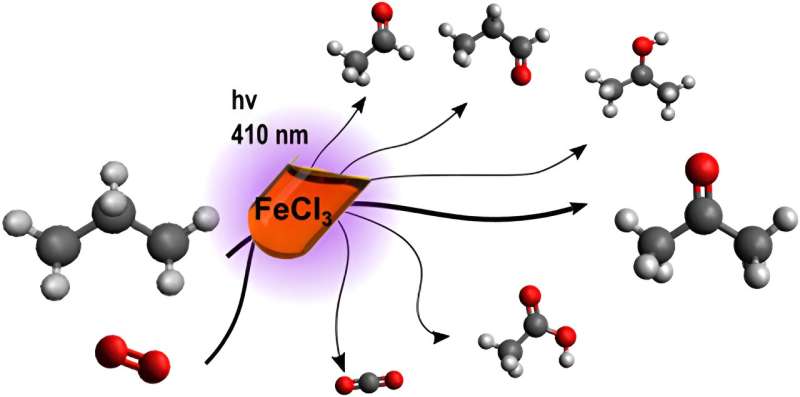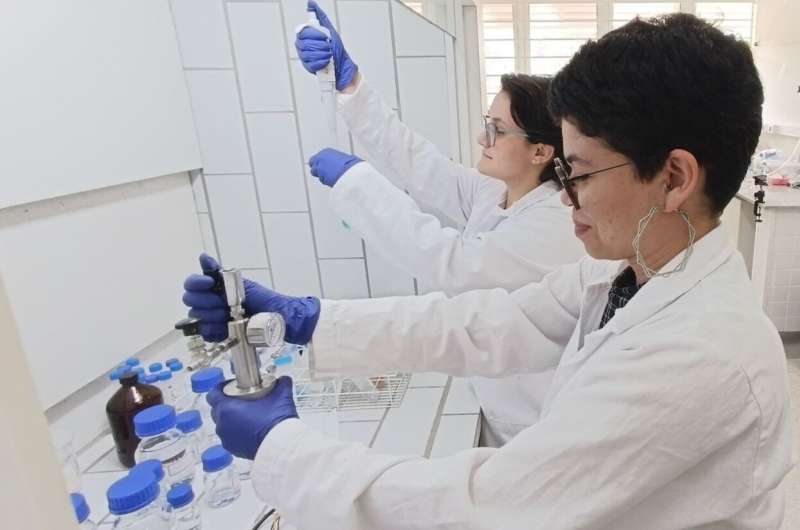This article has been reviewed according to Science X's editorial process and policies. Editors have highlighted the following attributes while ensuring the content's credibility:
fact-checked
peer-reviewed publication
trusted source
proofread
A novel method to obtain acetone in slow-cost, simple manner

Acetone is an essential chemical industry input and is used in the manufacturing of a wide array of products, such as adhesives, antibiotics, electronic components, solvents and removers, inks and vitamins, among others. Its production is complex and hazardous. To simplify the process and make it safer and cheaper, researchers in Brazil and Germany have developed an innovative method that uses only light and photoactive iron chloride (FeCl3), an inexpensive chemical compound.
An article on the research is published in the journal ACS Catalysis.
The standard acetone manufacturing process, known as the Hock or cumene process, comprises several stages. Propane, a petroleum product, is converted to propylene, a highly flammable gas, which is reacted with benzene and then with oxygen at high temperatures and pressures to give rise to acetone. These reactions also produce phenol, a compound for which there is less demand but which can be converted to value-added substances, although this is costly.
The alternative method developed by scientists affiliated with the Federal University of São Carlos (UFSCar) and the Federal University of Minas Gerais (UFMG) in Brazil, in collaboration with colleagues at the Max Planck Institute of Colloids and Interfaces in Germany, is based on propane oxidation and a photocatalytic reaction using iron chloride as a homogeneous catalyst in the presence of light.
"We discovered that when iron chloride is irradiated at certain wavelengths, it produces the radical chlorine, which is a potent oxidant and cleaves the bond between carbon and hydrogen [activates the C-H bond], giving rise to a radical that leads in the presence of oxygen to the formation of acetone," said Ivo Freitas Teixeira, a professor in UFSCar's Department of Chemistry and last author of the article. "We achieved a very important reaction in an absolutely different manner and using very simple elements."

Proof that the reaction was genuinely driven by chlorine radicals produced by Fe-Cl photolysis was obtained by means of mechanistic studies, including mass spectrometry, an analytical technique that identifies the components of a mixture by determining the molecular weight of their particles.
Among the advantages of the process is the fact that it is direct—skipping the production of propylene in intermediate stages—and safer as it does not involve oxygen reactions at high temperatures and pressures or flammable and hazardous intermediaries. In addition, it lowers energy consumption and cost because it has fewer stages and occurs at room temperature (25 °C).
The experiments used light-emitting diodes (LEDs) as a light source, but the researchers plan to use sunlight instead in future, making the method even more sustainable.
Patent application and next steps
A patent application has been filed with the National Industrial Property Institute (INPI), Brazil's patent office, and partnerships with companies are being sought to scale up and commercialize the new process. "It could become absolutely disruptive for acetone production in the chemical industry, enhancing safety and sustainability, and paving the way to direct production of acetone, which would cut costs and increase competitiveness," Teixeira said.
The main challenges, he added, are the large scale of processes in the petrochemical industry, and the fact that as yet there are no commercial photocatalysis methods.
The research also continues to develop in two directions: testing of the new method with other substances, such as methane; and seeking ways to scale up the process so as to increase industrial production and yield.
More information: Andrea Rogolino et al, Direct Synthesis of Acetone by Aerobic Propane Oxidation Promoted by Photoactive Iron(III) Chloride under Mild Conditions, ACS Catalysis (2023). DOI: 10.1021/acscatal.3c02092
Journal information: ACS Catalysis
Provided by FAPESP





















